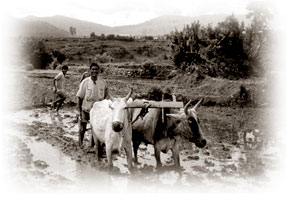Credit crisis and the future of farmers
by Indeewara Thilakarathne
[email protected]
Micro-credit is the granting of small loads (micro-loans) to the
unemployed, poor businessman and vulnerable sections of the population
who are inaccessible to credit in conventional banking system.
Micro-credit is a part of micro-financing, a provision of diverse
financial services to the poor.
 This concept originated with the overwhelming success story of
Grameen Bank in Bangladesh which was founded by legendary Muhammad Yunus,
a Professor of Economics at the Chittagong University in 1974. This concept originated with the overwhelming success story of
Grameen Bank in Bangladesh which was founded by legendary Muhammad Yunus,
a Professor of Economics at the Chittagong University in 1974.
Although the micro-financing may not solve the present credit crisis
in the agricultural sector, infusing some finance even in minuscule
scale would help ease the crisis and ensue a supply of credit for
farmers at any given time from cultivation to harvesting.
As micro-financing is gaining ground especially in developing
countries, Sri Lankan’s financial institutions also began to provide
micro-financing facilities in some vital sectors of the economy such as
agriculture, fisheries and small scale enterprises.
“SANASA Development Bank provides micro-financing for farmers
covering the entire production process from crop cultivation to
harvesting. Micro-credit, depending on requirement, will provide a sum
from Rs. 5000 to Rs. 200,000.
The micro-financing schemes cover wider areas including fishery,
cultivation, home gardening and even composting,” said Nihal Ramanayaka,
AGM (Credit) of the SANASA Development Bank which has one million
members grouped into 8,500 SANASA primary societies in diverse parts of
the country.
According to Ramanayake, SANASA, which has been ranked among the top
50 micro-credit institutes by Forbes Magazine, has so far provided
micro-financing facilities for a large number of farmers SANASA has
recorded an impressive re-payment rate.
Though micro-financing may provide a short term solution to problems
faced by the farmers, the agricultural sector cannot be made profitable
unless drastic measures are taken to right the market conditions and
also to reduce cost of production.
Prof. Mohammad Yunus states that traditional notion of micro-credit
is broad and misleading. He loosely classifies micro-credit into several
forms such as traditional informal microcredit (such as, moneylender’s
credit, pawn shops, loans from friends and relatives, consumer credit in
informal market, etc.), microcredit based on traditional informal groups
(such as, tontin, su su, ROSCA, etc.), Activity-based microcredit is
also given through conventional or specialised banks (for, agricultural
credit, livestock credit, fisheries credit, handloom credit, etc.),
Rural credit through specialised banks, Cooperative microcredit
(cooperative credit, credit union, savings and loan associations,
savings banks, etc.), as well as Consumer microcredit, that is Bank-NGO
partnerships based on microcredit, Grameen type microcredit or
Grameencredit and other types of NGO microcredit.
However, among the salient features of the micro-credit schemes,
providing loan facilities with absolutely no collaterals: loans are
given on trust and often the targeted groups are the poorest of the poor
who are out of conventional bank system, are prominent.
Major issue in agricultural sector
One of the major issues in the agricultural sector is the absence of
the purchasing mechanism for agricultural products. It has an adverse
effect on rice cultivation.
Though earlier this had to a certain extent, been cushioned out by
Government intervention through the Paddy Marketing Board which set a
price for each unit of purchasing paddy, the situation became worse with
the abolition of it.
Earlier the minimum price compelled the private buyers either to
purchase paddy at the set price or for a higher price.
At present farmers find it hard to sell their bounty harvest for a
reasonable price. Farmers also could not keep the harvest as the
existing storage facilities are incapable of coping with the volume.
A low price for agricultural products dissuades prospective youth
from engagement in agriculture, triggering off an exodus of youth to
cities, in search of jobs. Though the youth themselves can not be blamed
for the situation, this migration has created a shortage of labour in
the agricultural sector, hampering the growth in this vital sector which
is highly labour intensive.
Another factor which inhibits growth in agricultural sector is the
fragmentation of land and reclamation of land for commercial housing
schemes.
A low price for agricultural products has substantially contributed
to rural poverty, triggering off a vicious cycle of lack of income, poor
savings and zero investment.
In fact, farmers could not recover the cost of production.
Unlike in the past, as farmers have to rely on chemical fertilizer,
pesticides, the cost of production has been increased.
Although micro-financing will not make a sea change in agriculture,
at the initial stage infusion of money will ease the burden of the
farmer who is caught in a credit crisis. Perhaps, the best form of
micro-credit in this sector is Grameen credit which will not only have a
control over spending but also able to unite the farming community in
terms of formal groups.
Small loans would help farmers to buy required inputs without
mortgaging the harvest to money lenders.
The loose-knit grouping such as the co-operative type societies
would, in the long run, strengthen communities leading to the formation
of social capital.
However, the salvation of agriculture cannot be handed over to
micro-financing. Even if micro-financing would lift farmers out of
absolute poverty, their economic and social progress is by and largely
dependent on stable prices for agricultural products and the drastic
reduction of basic inputs such as fertilizer and seed.
The government’s direct intervention is needed in creating a
conducive economic environment for agriculture and securing a fare deal
between farmers and consumers. |
